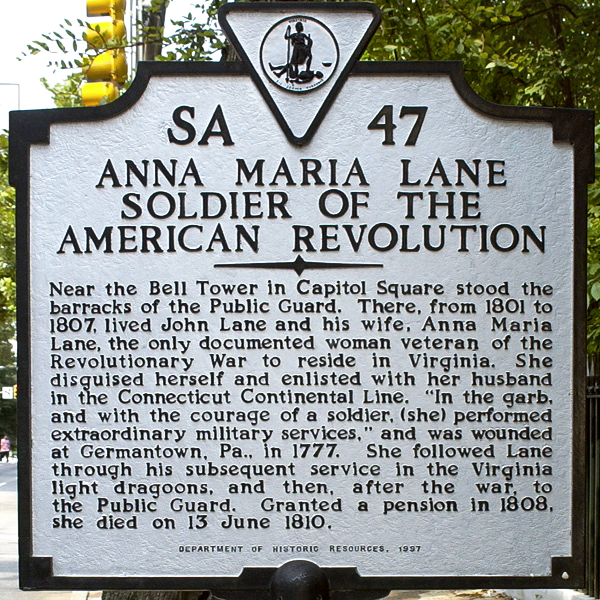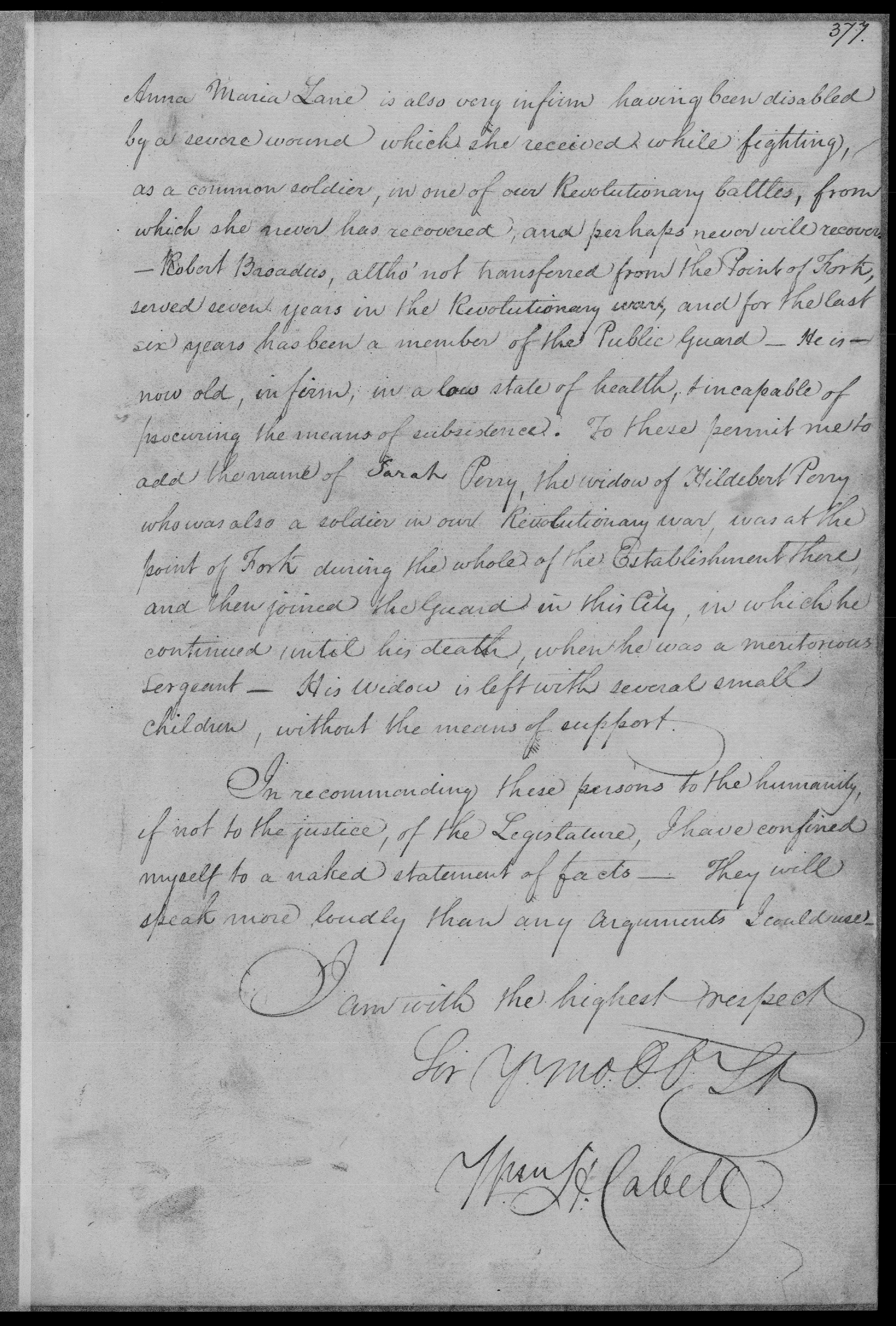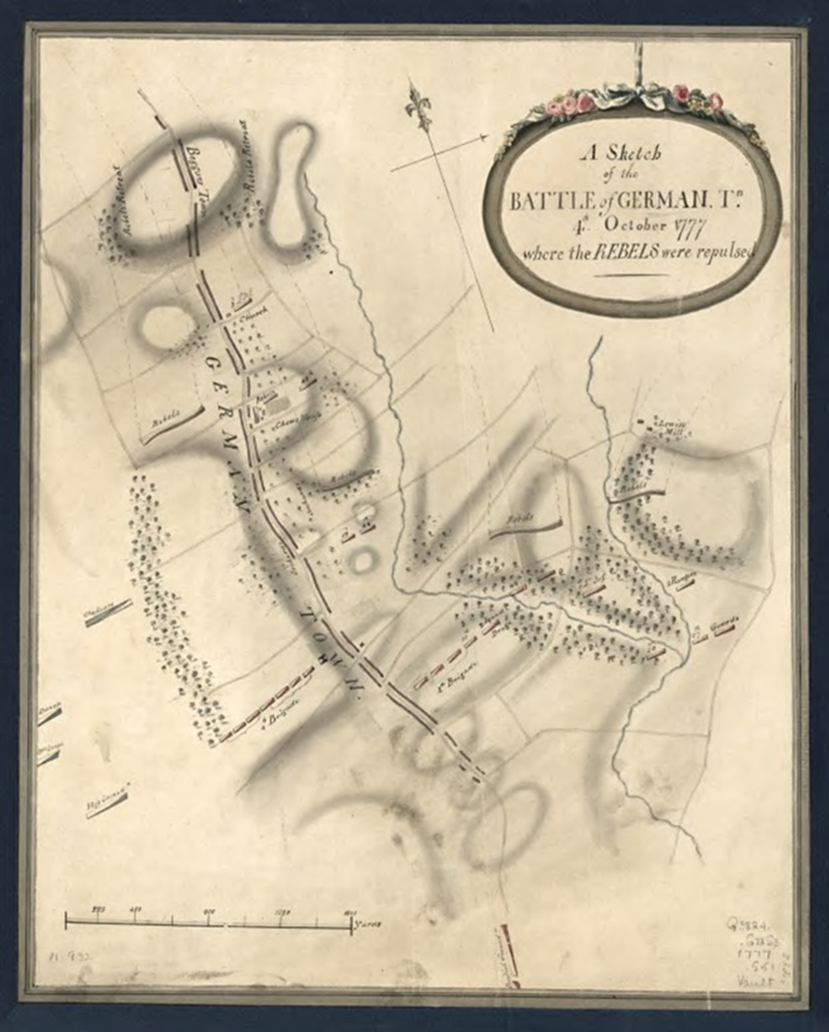|
 Anna Maria Lane had virtually
been forgotten for more than a century after
her death until the discovery of the
Virginia Pension records in 1928 by the
editor of the Richmond Magazine,
John Archer Carter. He also submitted an
article to the DAR Magazine May 1928
entitled “A Virginian Heroine.” In
1978, E.M. Sanches-Saavedra pieced to
together more information while compiling A
Guide to Virginia Military Organizations
in the American Revolution,
1774-1787. Despite this, most
Americans are unaware of Anna Maria Lane and
she had been forgotten during the
bicentennial years. We hope to highlight
Anna Maria Lane’s heroism for the upcoming
semiquincentennial years. Anna Maria Lane had virtually
been forgotten for more than a century after
her death until the discovery of the
Virginia Pension records in 1928 by the
editor of the Richmond Magazine,
John Archer Carter. He also submitted an
article to the DAR Magazine May 1928
entitled “A Virginian Heroine.” In
1978, E.M. Sanches-Saavedra pieced to
together more information while compiling A
Guide to Virginia Military Organizations
in the American Revolution,
1774-1787. Despite this, most
Americans are unaware of Anna Maria Lane and
she had been forgotten during the
bicentennial years. We hope to highlight
Anna Maria Lane’s heroism for the upcoming
semiquincentennial years.
 Most
of Anna Maria Lane’s history has been lost
to time but the affidavit submitted by her
husband John Lane, supporting his federal
pension application (S38129) dated 1819
provides several clues. John was born in
1726 or 1727 and enlisted in Continental
army in 1776. His company served in a
company commanded by Captain Lucas 4th
Regiment, commanded by Colonel Willis in the
brigade under General Israel Putnam assigned
to the Connecticut line. Lane remained in
the Continental Army for three years serving
in the battles of White Planes (28 October
1776), Trenton (26 December 1776), Princeton
(3 January 1777), Germantown (4 October
1777) and Savannah (9 October 1779). He was
severely injured at Savannah and taken
prisoner according to his pension affidavit. Most
of Anna Maria Lane’s history has been lost
to time but the affidavit submitted by her
husband John Lane, supporting his federal
pension application (S38129) dated 1819
provides several clues. John was born in
1726 or 1727 and enlisted in Continental
army in 1776. His company served in a
company commanded by Captain Lucas 4th
Regiment, commanded by Colonel Willis in the
brigade under General Israel Putnam assigned
to the Connecticut line. Lane remained in
the Continental Army for three years serving
in the battles of White Planes (28 October
1776), Trenton (26 December 1776), Princeton
(3 January 1777), Germantown (4 October
1777) and Savannah (9 October 1779). He was
severely injured at Savannah and taken
prisoner according to his pension affidavit.
Anna Maria Lane with little or no means of
support may have just been one of the many
camp followers offering services to the army
as a cook, nurse, laundress or seamstress.
However, she may have also disguised her sex
and enlisted in her husband’s unit, a
deception much like Deborah Sampson. Army
life was not easy during the Revolution War,
and many poor women chose this life to have
refuge from starvation. In August 1777,
General George Washington complained
bitterly that the camp followers were a
“clog upon every movement” and instructed
his officers to prohibit all but essential
women to remain with the troops.
John and Anna Maria Lane probably joined
Washington’s army outside Philadelphia in
September 1777, accompanying nine hundred
reinforcements dispatched by General Putnam
to aid the commander in chief. Following the
British capture of Philadelphia on 26
September 1777, Washington decided to attack
General William Howe’s British forces camped
in the village of Germantown just northwest
of the Pennsylvania capital. On the night of
3 October 1777, the Lanes along with four
converging American units began a
sixteen-mile march towards Germantown.
Although Howe received some intelligence of
an impending attack, he did little to
prepare in advance. Then around 5:30 in the
morning on 4 October, they arrived on the
outskirts of Germantown. General John
Sullivan's troops surprised Howe's and
forced them back towards Germantown.
Confusion started as the dense fog from the
early morning hours and canon smoke
blanketed the battlefield. Approximately 100
British soldiers took refuge in a large
stone mansion also known as Cliveden or the
Chew House that was owned by a Loyalist
family. Sullivan wisely bypassed the
structure and continued his advance over a
mile, driving the British from a series of
fenced yards in the town. General Nathanael
Greene, who was delayed on the long march,
opened his attack about an hour later and
captured part of the British. With victory
seemingly in sight, however, the American
attack unraveled.
 Sullivan's troops were
running low on ammunition and came under a
volley of friendly fire from Greene's men,
who became disoriented in the fog. In
addition, the militia columns failed to
encircle Howe's flanks. Washington, on the
advice of artillery commander Henry Knox,
decided to attack the sturdy building rather
than isolate it with a small force. For two
hours a Continental brigade supported by
cannons unsuccessfully tried to storm the
mansion and suffered heavy losses. This
action diverted troops from Sullivan's main
advance and also from Greene's, as some of
his soldiers joined the assault. Other
American troops retreated when they heard
the heavy firing towards the rear, fearing
that they were encircled. Such distractions
allowed Howe time to organize a
counterattack with fresh troops. Sullivan's troops were
running low on ammunition and came under a
volley of friendly fire from Greene's men,
who became disoriented in the fog. In
addition, the militia columns failed to
encircle Howe's flanks. Washington, on the
advice of artillery commander Henry Knox,
decided to attack the sturdy building rather
than isolate it with a small force. For two
hours a Continental brigade supported by
cannons unsuccessfully tried to storm the
mansion and suffered heavy losses. This
action diverted troops from Sullivan's main
advance and also from Greene's, as some of
his soldiers joined the assault. Other
American troops retreated when they heard
the heavy firing towards the rear, fearing
that they were encircled. Such distractions
allowed Howe time to organize a
counterattack with fresh troops.
Anna Maria Lane performed “extraordinary
military services” at Germantown on behalf
of the American cause and received a wound
that left her lame for life. We do not know
if she enlisted in the Continental Line
weeks or months before Germantown, or if it
was on the eve of the battle to don
“soldier’s garb.” Was Anna Maria Lane one of
those who made a valiant charge when others
retreated? We may never know what
extraordinary services she provided because
it was never recorded within the Virginia
General Assembly petition for pension in
1808.
A year after Germantown, John Lane
participated in the battle of Savannah,
Georgia on 9 October 1779 where he was
severely wounded and captured. According to
his pension John was released in an
“exchange” and found his way back to
Virginia where he re-enlisted for the
duration of the war under Major John
Nelson’s regiment of the Virginia Light
Dragoons. In April of 1781, Major Nelson
complained to Governor Thomas Jefferson that
his men had not been paid for over a year
and that many of them were “without a shirt
or breeches”. John Lane remained in service
until the end of the war when he was
honorably discharged in Hampton, Virginia by
Major John Nelson.
On 16 July 1783 John Lane enlisted in the
Virginia state guard at Richmond. He must
have concealed the fact that he was seven
years older than the fifty-year age limit.
The Lanes must have been desperate for the
mere $6.66 quarterly income. Records prove
that Anna Maria and one of their children
drew daily rations along with the troops.
Then in 1791, when the number of state
guardsmen was reduced due to economic
measures, John Lane was one of three
veterans allowed to remain despite his age.
When the Point of Fork, Virginia guard was
disbanded in 1801, the General Assembly of
Virginia created a new public guard that
consisted of sixty- eight soldiers
responsible for protecting all public
property in Richmond. John Lane who was now
seventy-five enlisted. The Lanes moved to
Richmond where John continued to work in the
new Public Guard. Richmond historian Samuel
Mordecai writes of the old quarters located
at the present day Bell Tower in Richmond
that, "The grounds immediately around it
were bedecked with the shirts of the
soldiers and the chemises of their wives,
which flaunted on clothes- lines, and pigs,
poultry and children enlivened the scene."
One can't help but think that this picture
might resemble life for Anna as a camp
follower.
 In
January 1802, Anna Maria Lane also
volunteered to assist the city physicians.
It was here a physician by the name of John
H. Foushee, petitioned Governor James Monroe
asking for a small allowance. Foushee
stated, “As the old woman is lame, and has
discovered a disposition to assist the sick
as far as she is able, I think it would be
well to make her some moderate compensation,
but not as will establish her as a permanent
nurse.” Anna Maria Lane received £1 a month
through September 1804, when she apparently
ceased working most likely because of her
own deteriorating health. In
January 1802, Anna Maria Lane also
volunteered to assist the city physicians.
It was here a physician by the name of John
H. Foushee, petitioned Governor James Monroe
asking for a small allowance. Foushee
stated, “As the old woman is lame, and has
discovered a disposition to assist the sick
as far as she is able, I think it would be
well to make her some moderate compensation,
but not as will establish her as a permanent
nurse.” Anna Maria Lane received £1 a month
through September 1804, when she apparently
ceased working most likely because of her
own deteriorating health.
John Lane’s physical condition also
deteriorated and by March 1807 he became too
infirm for guard duty. On January 28, 1808,
the Virginia Governor William Cabell sent a
letter to the Speaker of the House, Hugh
Nelson, that calls for granting of pensions
to several servicemen and women, one of them
being Anna Maria Lane. In Cabell’s letter,
he provided a brief explanation of the
services of each man and woman, in an
attempt to persuade the Speaker to fulfill
the request on behalf of several veterans
and their families, including the Lanes.
Cabell’s letter reads as follows: “They
have been worn out in public service; now
without property or money and their age
and infirmities rendering them unable to
procure, either they must be sent forth to
beg or starve, unless the humanity of this
Legislature shall interfere — Their names
are John Hays, William Hopkins, & John
Lane—The wife of the last Anna Maria
Lane is also very infirm having been
disabled by a severe wound which she
received while fighting, as a common
soldier, in one of our Revolutionary
battles, from which she has never
recovered, and perhaps never will
recover.” Shortly after Cabell’s
request, both John and Anna received a
pension. John received the typical $40 a
year while Anna received $100 a year, which
was 2 ½ times the amount of her male
counterparts. One may never know what part
Anna Maria Lane truly played but it is known
she participated as a soldier, and was
wounded during the Battle of Germantown,
that left lame. Anna Maria must not have
been any ordinary camp follower and her
story must have impressed the assembly to be
awarded a pension of this magnitude. This
woman surely must have done something heroic
to be awarded a pension that was 2 ½ times
the amount of the other pensioners. One may
never know the real story.
Anna Maria Lane accompanied her husband
John to the Capitol in Richmond during the
spring and summer of 1808 to collect their
pensions, which was dispersed quarterly.
Among the pension records that survive is
her mark, made in lieu of a signature, found
among the records in the auditor’s office.
This signifies most likely she was most
likely uneducated and illiterate. She
continued to collect this pension another
two years until her death 13 June 1810.
Unable to survive without his wife's
pension, John Lane eventually resided in the
Richmond City Poorhouse. Records in his
pension reveal that he requested a few of
his quarterly disbursements to be given to
his daughter Sarah. On 5 July 1819, his
federal pension application S38129 mentions
that he was 93 years old. John Lane survived
four more years and he died 14 July1823.
Little is known about women’s military
roles in the Revolutionary War, not because
they did not participate but rather few
documents survive to support their
activities or that the evidence has been
overlooked. We would like to make Anna Maria
Lane a name that is well known for her
“extraordinary military services” rendered
during the Revolutionary War. Most of all,
we would like to pay homage to Anna Maria
Lane for the upcoming semiquincentennial
celebration hoping to locate her
descendants.
References
- Treadway, Sandra Gioia. “Anna Maria
Lane: An Uncommon Soldier of the American
Revolution.” Virginia Cavalcade 37, no. 3
(1988): 134–143.
- "Working Out Her Destiny – Where are the
Women: Examples from the LVA Collections".
Retrieved 12 July 2020.
- Gabriel, M. P., PhD. (n.d.). Battle of
Germantown. Retrieved 12 July 2020, from
https://www.mountvernon.org/library/digitalhistory/digital-encyclopedia/article/battle-of-
germantown/?gclid=EAIaIQobChMIyard7amb7AIVXgiICR0I6gmZEAAYASAAEgL5XfD_BwE
- Tendrich Frank, Lisa, An Encyclopedia
of American Women at War: From the Home
Front to the Battlefields, Volume 1
ABC-CLIO, 2013 pg 350-351.
- Henry, Joyce. (n.d) Colonial
Williamsburg podcasts Women Soldiers.
Retrieved 12 July 2020, from
https://podcast.history.org/2010/05/31/women-soldiers/
- Selected records from Revolutionary War
Pension files. Database and images from
http://fold3.com Retrieved July 15, 2020,
Citing NARA microfilm publication M804.
Washington, D.C.: National Archives and
Records Administration, 1974.
- History.com Editors. (2009, November
09). Battle of Germantown. Retrieved 15
July 2020, from
https://www.history.com/topics/american-revolution/battle-of-germantown
- Carter, John Archer. “A Virginia
Heroine.” Daughters of the American
Revolution Magazine 62, no. 5 (1928)
289-292.
- Find a Grave, database and images
accessed 14 November 2020, memorial page
for Anna Maria Lane (1755–13 Jun 1810),
Find a Grave Memorial no. 195050579;
Maintained by Kathy Jennings Brown
(contributor 47272624) Burial Details
Unknown.
- Find a Grave, database and images
accessed 14 November 2020, memorial page
for John Lane (1723–1823), Find a Grave
Memorial no. 57163122, citing Shockoe Hill
Cemetery, Richmond, Richmond City,
Virginia, USA ; Maintained by Victor E.
Everhart, PhD (contributor 47774451) .
- Acts Passed at a General Assembly of the
Commonwealth of Virginia. (1808). United
States: (n.p.). An Act placing on the list
of Pensioners certain Persons therein
named (General Assembly of Virginia; Feb.
6, 1808) 97 pg 81.
- Library of Virginia. Retrieved 15 July
2020 from https://edu.lva.virginia.gov/
online_classroom/shaping_the_constitution/doc/lane
- Ward, Harry M. “For Virginia and For
Independence: Twenty-eight Revolutionary
War Soldiers from the Old Dominion.”
Jefferson, North Carolina: McFarland &
Company Inc., 2011, 139-142
|

